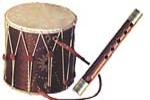 |
| |
|  |

|

|
|
Flabiol and tabor
Although it is thought that the happy notion of a single instrumentalist playing the flabiol or tabor pipe
and the tabor or drum itself, which first appeared in Europe in the thirteenth century, came from North Africa
with the Moors or returned from the Holy Lands with the Crusaders, there is nothing in the written or pictorial
record to support this. Its origins are unknown. And, however unlikely it may be, within twenty to thirty years
of its first appearance, the pipe and tabor were widespread in Europe.
The flabiol is pipe with up to five holes whose range exceeds two octaves. In the Balearic Islands
it is also used as a solo instrument with its own melodies. It is played with one hand, leaving
the other free to play the tabor, a small drum carried under the left elbow.
Playing it with two hands, which allowed the instrumentalist to produce lower notes, seems to have waned.
The winding melody and intricate vocal ornaments of the Mallorcan agricultural work songs are in a style often ascribed to Jewish or to Moorish influence.
|
|
|